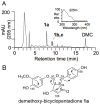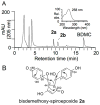Oxidative Transformation of Demethoxy- and Bisdemethoxycurcumin: Products, Mechanism of Formation, and Poisoning of Human Topoisomerase IIα
- PMID: 25806475
- PMCID: PMC4437832
- DOI: 10.1021/acs.chemrestox.5b00009
Oxidative Transformation of Demethoxy- and Bisdemethoxycurcumin: Products, Mechanism of Formation, and Poisoning of Human Topoisomerase IIα
Abstract
Extracts from the rhizome of the turmeric plant are widely consumed as anti-inflammatory dietary supplements. Turmeric extract contains the three curcuminoids, curcumin (≈80% relative abundance), demethoxycurcumin (DMC; ≈15%), and bisdemethoxycurcumin (BDMC; ≈5%). A distinct feature of pure curcumin is its instability at physiological pH, resulting in rapid autoxidation to a bicyclopentadione within 10-15 min. Here, we describe oxidative transformation of turmeric extract, DMC, and BDMC and the identification of their oxidation products using LC-MS and NMR analyses. DMC autoxidized over the course of 24 h to the expected bicyclopentadione diastereomers. BDMC was resistant to autoxidation, and oxidative transformation required catalysis by horseradish peroxidase and H2O2 or potassium ferricyanide. The product of BDMC oxidation was a stable spiroepoxide that was equivalent to a reaction intermediate in the autoxidation of curcumin. The ability of DMC and BDMC to poison recombinant human topoisomerase IIα was significantly increased in the presence of potassium ferricyanide, indicating that oxidative transformation was required to achieve full DNA cleavage activity. DMC and BDMC are less prone to autoxidation than curcumin and contribute to the enhanced stability of turmeric extract at physiological pH. Their oxidative metabolites may contribute to the biological effects of turmeric extract.
Figures









Similar articles
-
Degradation of Curcumin: From Mechanism to Biological Implications.J Agric Food Chem. 2015 Sep 9;63(35):7606-14. doi: 10.1021/acs.jafc.5b00244. Epub 2015 Apr 2. J Agric Food Chem. 2015. PMID: 25817068 Free PMC article. Review.
-
Oxidative metabolites of curcumin poison human type II topoisomerases.Biochemistry. 2013 Jan 8;52(1):221-7. doi: 10.1021/bi3014455. Epub 2012 Dec 26. Biochemistry. 2013. PMID: 23253398 Free PMC article.
-
Mechanistic Differences in the Inhibition of NF-κB by Turmeric and Its Curcuminoid Constituents.J Agric Food Chem. 2020 Jun 3;68(22):6154-6160. doi: 10.1021/acs.jafc.0c02607. Epub 2020 May 20. J Agric Food Chem. 2020. PMID: 32378408 Free PMC article.
-
Protective Effects of Minor Components of Curcuminoids on Hydrogen Peroxide-Treated Human HaCaT Keratinocytes.J Agric Food Chem. 2016 May 11;64(18):3598-608. doi: 10.1021/acs.jafc.6b01196. Epub 2016 Apr 28. J Agric Food Chem. 2016. PMID: 27094403
-
The Golden Spice for Life: Turmeric with the Pharmacological Benefits of Curcuminoids Components, Including Curcumin, Bisdemethoxycurcumin, and Demethoxycurcumins.Curr Org Synth. 2024;21(5):665-683. doi: 10.2174/1570179420666230607124949. Curr Org Synth. 2024. PMID: 37287298 Review.
Cited by
-
Degradation of Curcumin: From Mechanism to Biological Implications.J Agric Food Chem. 2015 Sep 9;63(35):7606-14. doi: 10.1021/acs.jafc.5b00244. Epub 2015 Apr 2. J Agric Food Chem. 2015. PMID: 25817068 Free PMC article. Review.
-
Thiol Reactivity of Curcumin and Its Oxidation Products.Chem Res Toxicol. 2018 Apr 16;31(4):269-276. doi: 10.1021/acs.chemrestox.7b00326. Epub 2018 Mar 28. Chem Res Toxicol. 2018. PMID: 29569909 Free PMC article.
-
Curcumin induces secretion of glucagon-like peptide-1 through an oxidation-dependent mechanism.Biochimie. 2019 Oct;165:250-257. doi: 10.1016/j.biochi.2019.08.013. Epub 2019 Aug 27. Biochimie. 2019. PMID: 31470039 Free PMC article.
-
Effect of curcuminoids and curcumin derivate products on thioredoxin-glutathione reductase from Taenia crassiceps cysticerci. Evidence suggesting a curcumin oxidation product as a suitable inhibitor.PLoS One. 2019 Jul 22;14(7):e0220098. doi: 10.1371/journal.pone.0220098. eCollection 2019. PLoS One. 2019. PMID: 31329647 Free PMC article.
-
Perspective on Improving the Relevance, Rigor, and Reproducibility of Botanical Clinical Trials: Lessons Learned From Turmeric Trials.Front Nutr. 2021 Dec 3;8:782912. doi: 10.3389/fnut.2021.782912. eCollection 2021. Front Nutr. 2021. PMID: 34926556 Free PMC article. Review.
References
-
- Esatbeyoglu T, Huebbe P, Ernst IM, Chin D, Wagner AE, Rimbach G. Curcumin-from molecule to biological function. Angew Chem Int Ed Engl. 2012;51:5308–5332. - PubMed
-
- Norris L, Karmokar A, Howells L, Steward WP, Gescher A, Brown K. The role of cancer stem cells in the anti-carcinogenicity of curcumin. Mol Nutr Food Res. 2013;57:1630–1637. - PubMed
-
- Heger M, van Golen RF, Broekgaarden M, Michel MC. The molecular basis for the pharmacokinetics and pharmacodynamics of curcumin and its metabolites in relation to cancer. Pharmacol Rev. 2014;66:222–307. - PubMed
Publication types
MeSH terms
Substances
Grants and funding
- T32 GM007628/GM/NIGMS NIH HHS/United States
- F31 AT007287/AT/NCCIH NIH HHS/United States
- GM033944/GM/NIGMS NIH HHS/United States
- AT006896/AT/NCCIH NIH HHS/United States
- P50 CA095103/CA/NCI NIH HHS/United States
- 5P50CA095103/CA/NCI NIH HHS/United States
- P30 DK058404/DK/NIDDK NIH HHS/United States
- R01 AT006896/AT/NCCIH NIH HHS/United States
- R25 GM062459/GM/NIGMS NIH HHS/United States
- R03 CA159382/CA/NCI NIH HHS/United States
- CA159382/CA/NCI NIH HHS/United States
- P30DK058404/DK/NIDDK NIH HHS/United States
- R01 GM033944/GM/NIGMS NIH HHS/United States
- F31AT007287/AT/NCCIH NIH HHS/United States
- 2T32GM07628/GM/NIGMS NIH HHS/United States
LinkOut - more resources
Full Text Sources
Other Literature Sources

